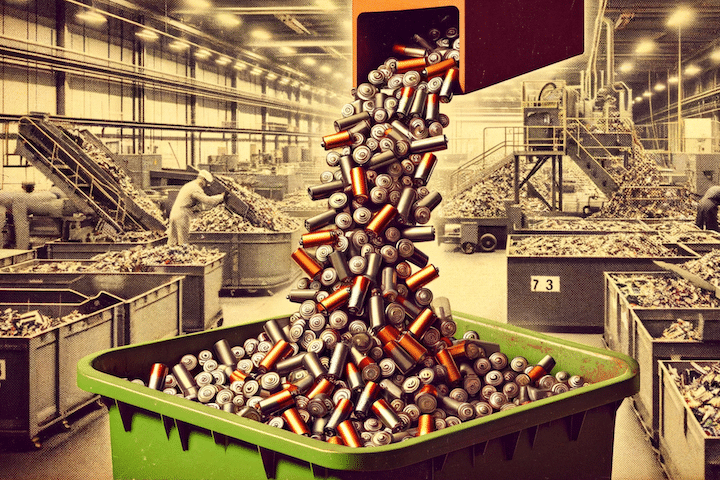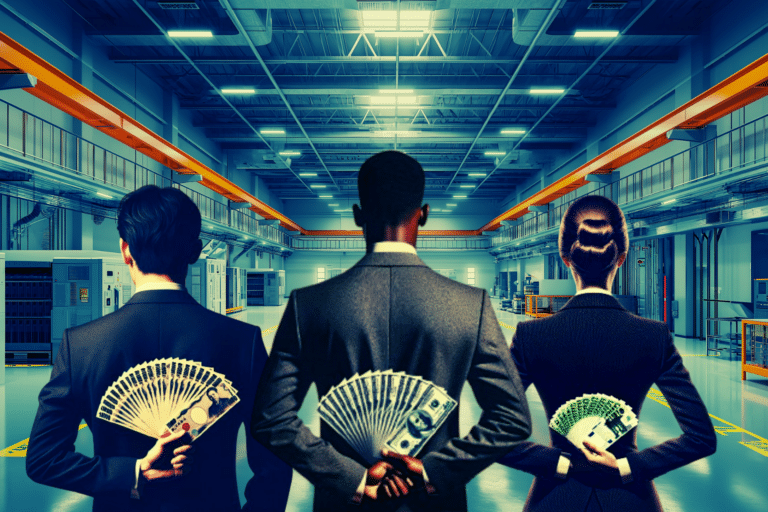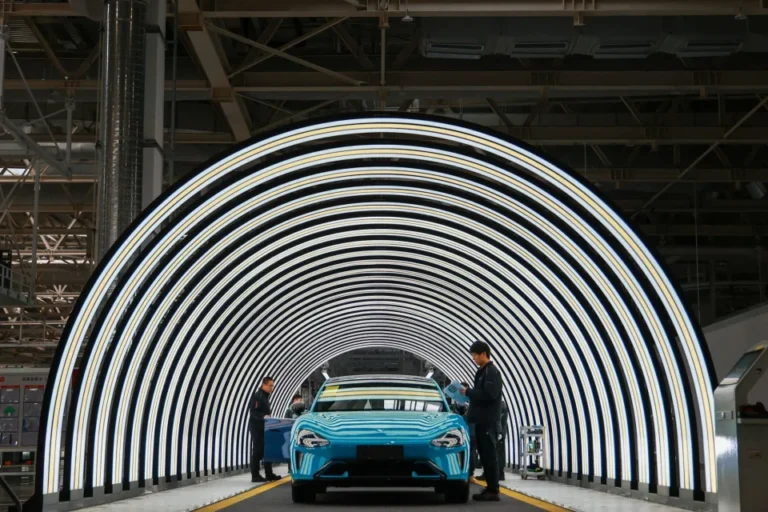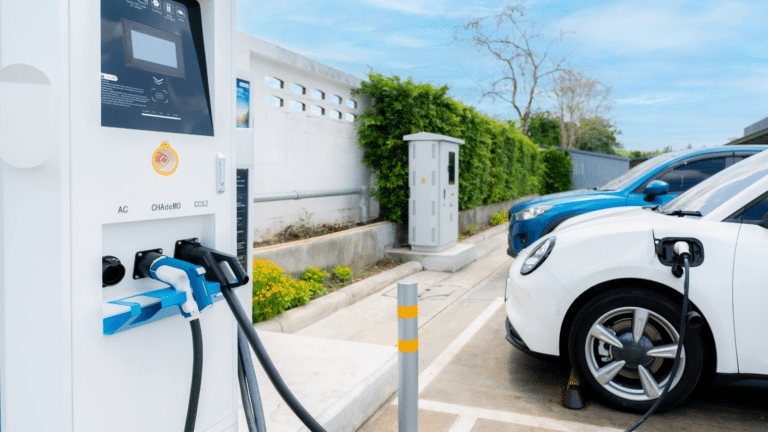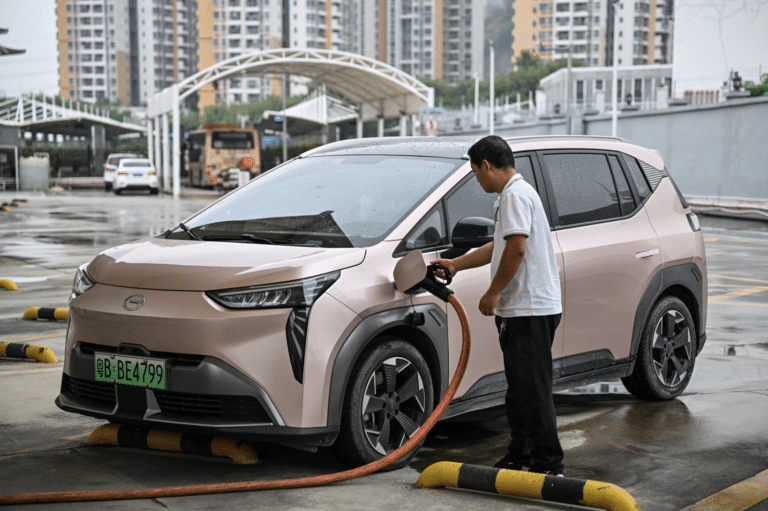Melissa Lott: [00:00:00] Last fall, we did a whole series that was dedicated to decarbonizing our transportation sector. And you might remember the story about temperatures, road trip, where he drove his electric vehicle across the country and up into Alaska, learning a lot about the nation’s charging infrastructure in the process. Well, since we released that episode, there’s been some pretty major developments in the world of transport decarbonization, particularly when it comes to electric vehicles. [00:00:23][23.1]
News Anchor: [00:00:24] The state of. [00:00:24][0.3]
News Anchor: [00:00:24] California you’ve heard of before will have passed a new rule banning the sale of all gas powered vehicles by 2035. So there’s still some time. There’s some time. [00:00:33][9.2]
Melissa Lott: [00:00:37] Transportation is the biggest source of greenhouse gas emissions in California. But on August 25th of this year, CARB, which stands for the California Air Resources Board, which is this organization that deals with regulating air quality in California, Well, CARB made a pretty big move to change that. They approved a rule mandating that by 2035, all new cars that are sold in California will be zero emission vehicles or zevs like electric cars. This means that in a decade, cars in California might look very different than they do today. The state will need to build up charging infrastructure to meet the demand from lots of new electric vehicles. And as cars with combustion engines age out of the second hand market, the regulation sets California up for a zero emission and highly electrified future. The rule will also deliver some huge climate and health wins along the way. The agency estimates that by 2035, the regulation will result in 9.5 million fewer gas powered cars being sold. And in addition to helping the planet by slashing carbon emissions, having fewer fossil fuel cars on the road comes with some pretty major pollution benefits. According to CARB, the regulation will reduce deaths associated with pollution exposure and save Californians the equivalent of $13 billion in avoided health costs due to pollution from 2026 to 2040. California is not alone in this rule. New York is also banning gas powered car sales by 2035, and soon as many as 17 other states like Washington and Massachusetts, which currently have vehicle emission standards tied to California’s, may follow suit. This wave of regulation could change the face of American transit forever. This week, we’re talking with one of California’s most influential environmental regulators about how the ban on gas car sales in California came to be and how it will help the state to make the big switch towards a net zero future for transportation. This is the big switch, a show about how to rebuild the energy systems that are all around us. I’m Dr. Melissa Lott and I’m the director of research at Columbia University’s SIPA Center on Global Energy Policy. This landmark regulation in California didn’t just happen overnight. [00:02:54][137.5]
Mary Nichols: [00:02:55] To me, probably the biggest breakthrough in all of this is that when we began more recently to look at the possibility of phasing out internal combustion engines, there was no meaningful opposition to that coming from the auto industry. I mean, having litigated with them against them, you know, for years. We’re at a point now where there’s a pretty general consensus that we need to be moving in the direction of electric transportation. Electric transportation is the future, and government and industry have to work together to find ways to make it succeed. [00:03:39][44.7]
Melissa Lott: [00:03:40] This is Mary Nichols. She served twice as the chair of CARB under three different governors. And over her 50 year career, Nichols has championed clean air and advocated for the adoption of electric vehicles. She’s also currently a distinguished visiting fellow at the center that I work at here at Columbia University. I spoke to her about the long history that led up to carbs rule banning gas, car sales. I have heard you referred to, and I personally would agree with this one. I’ve heard you called the most influential environmental regulator in history like full stop. And I’m wondering, what does it mean to be an environmental regulator to you? Like, what does that even mean? [00:04:21][40.8]
Mary Nichols: [00:04:22] Maybe what I should say to sort of back this up is I am a lawyer and I sometimes I’m flattered when people say, Oh, gosh, I never would have thought you were a lawyer, because when they’re saying that, they usually mean, hey, you’re pretty nice, but you know, you’re not a jerk. But in fact, going to law school really has shaped my view of the world because I’m a believer that we can make things better using laws if those laws are enforced. And what I’ve done as an environmental regulator is primarily to take statutes that were passed by Congress or passed by the legislature, which generally speaking, have big grand language in them, like you will achieve healthy air quality by a certain date and figure out how to actually translate that into actions that can be taken and can be measured and can be monitored and can be enforced if people aren’t doing what they’re required to do. So it’s a fine art. And generally speaking, most people think regulation equals unpleasantness, right? We don’t usually ask to be regulated in our own lives. We tend to think of it as burdensome and restrictive and prescriptive. And you hear a lot, especially in the political arena, about how burdensome regulations are keeping people from building things or doing things. And the truth is that if regulations are not done thoughtfully and carefully and making use of all the tools that they can incorporate, they can have that effect without without a doubt. But the other side of the coin is that I think most thoughtful businesspeople will tell you that in any competitive market situation, they need to have a backstop of a regulation in order to keep a level playing field to make sure that competition is fair. And if you want to make change happen, whether it’s anything from having seatbelts in cars to assuring that, you know, the energy supply has an adequate mix of renewable electricity in it, you have to have some type of governmental regulation to make that happen. Now, there’s a lot of different agencies, a lot of different statutes, a lot of different ways of doing regulation. And sometimes it feels to me also like in our society, there are just too many regulations. You know, talk to anybody who’s tried to do a building project just, for example, or start a new business. And you can you can just go through a laundry list of things that you’re required to do. But when we want to make big, important things happen, like cleaning up the air or making the water supply safe, we need to have some form of legally enforceable rules to keep the society going. And that’s what I’ve worked on for. It now turns out about 50 years. [00:07:45][202.8]
Melissa Lott: [00:07:45] I know that you’ve long been like advocating for a target of having, you know, zero emission vehicle sales as quickly as possible, going, you know, to the vast majority of sales that are out there. But I’m wondering to what you were saying a minute ago, can you actually help me understand the regulatory journey that most of us don’t know about that was behind this thing that then became a headline that we’re all reading about, where it’s like, okay, 20, 35, no new gas powered cars. Can you talk me through the journey behind all of that A bit? [00:08:13][28.3]
Mary Nichols: [00:08:14] Well, when I first started working in this field back in the seventies, we had a mantra of performance based regulations and never putting your thumb on the scale of technology, but setting standards based on what the outcome you wanted to achieve was clean air, for example, and then working backwards from that direct industry to produce a product that would meet those standards, but not tell them exactly how to do that. And in the case of the automobile, of course, it’s complicated by the fact that you don’t just pick up a piece of technology and drive it. You have to have a fuel in it. So you’re really dealing with a with two complex large systems. Not just one. When you talk about when you talk about vehicle transportation. However, over the years, the thinking really evolved in the direction of saying, well, wait a minute, now we know that the internal combustion engine can get cleaner and cleaner and cleaner and we can put we can put add on technology at the tailpipe of a car like the catalytic converter, which was a huge breakthrough. And then the three way catalytic converter. And we can clean up the fuel and make the gasoline formula cleaner so that you get less emissions out of the tailpipe. But at the end of the day, it’s still combustion. And the move towards zero tailpipe emission vehicles really took a turn when we began to realize that it wasn’t just the nitrogen oxides and the volatile organic compounds and that particulates that were coming out of the vehicles that we needed to be worried about, that it was really the combustion of any kind of fuel that was going to be unacceptable if if we were going to be reaching the kind of goals, you know, that the science was telling us we needed to reach to, you know, to keep the planet from warming by more than 1.5 degrees centigrade. And if the U.S. and California, even though California itself is only one state where, you know, less than 1% of the global economy, but we’re a big contributor, even at 1%, we had to figure out what to do next. And so the battery vehicles and the fuel cell vehicles and advanced hybrids really began to rise to the fore. And we started thinking about actually mandating sales of zevs that that goes back really and to the nineties that we first started asking the manufacturers to to produce and sell increasing volumes of zero emission vehicles. But towards the last of you know, the well really towards that in the early 2000 we began to start thinking about maybe just having to end a life of the internal combustion engine and that led to what the governor did in putting out an executive order, telling CARB their resources board to develop regulations that would actually ban any sales of new internal combustion engines in California by 2035. [00:11:54][219.8]
Melissa Lott: [00:11:55] Were there any points in this? Because, I mean, that’s a 30 year journey. If you think back to the nineties, it’s longer than that. If you think back to the Clean Air Act over that 30 year period, did you see any points that were just major breakthroughs? I mean, the governor actually issuing that executive order, but a lot of stuff when it happened before that, I don’t know if there were any major points in the process that were adding some fuel to the fire of getting this moving forward, no pun intended. [00:12:18][23.1]
Mary Nichols: [00:12:19] Well, there were many battles along the way, but the requirement to meet a tailpipe standard that could only be met by using a catalytic converter was a big one. And one of the reasons why it was so important was that the catalysts wouldn’t function with leaded gasoline. So a side effect of having require the use of the catalyst is that it also required the oil industry to start producing much more unleaded gasoline and federal and state regulations to phase out all leaded gasoline, which was a program that was bitterly fought by the led industry, of course, but also by many, many people in the auto industry who thought that you really needed lead to make the cars run more efficiently, that the health impact of getting led out of gasoline probably is more important by any standard than the impact of the other kinds of pollutants that we reduce. And that was really an it was a side effect. It was an ancillary effect of having required the catalytic converter. So that was a huge breakthrough point in the seventies. [00:13:43][83.6]
Melissa Lott: [00:13:50] In California. You know, we often see the state kind of moving as a first mover in a lot of these things. So they’re the, you know, first to say, you know, we’re going to put this stake in this. And when it comes to environmental regulations and we’re going to keep moving forward and then you see a lot of different states and then different countries picking up lessons learned from the state. [00:14:05][14.9]
Mary Nichols: [00:14:05] Yeah. So first of all, I do want to say something about California and why it why it occupies this sort of unique place as a as a state that is known for being a first mover. I think our size and our diversity within the state have contributed to this. But the main thing that really has has helped us in terms of the climate regulatory field is the fact that we have the ability to set our own emission standards for motor vehicles. It was built into the 1970 original Clean Air Act. And California governors, both Republican and Democrat and California senators, both Republican and Democrat, have fought over the years. And during my time as as the head of the state air agency, I thought my number one priority, the one thing that I absolutely have had to do was to protect that ability at all costs, because that gave us the chance to develop our own programs. And once we survived the litigation test of whether what we were doing was really technically feasible and necessary to clean up the air, which it always was, we were able to move on our own without waiting for the federal government to allow us to do things. So we’re a big state and we’re a prosperous state. We have a big economy and we have this special weapon that nobody else has. And I think that’s probably been the main feature that allowed us to have that confidence over the years of having done the regulations, seen them work, that we could also continue to innovate and make progress in the future. [00:16:00][114.5]
Melissa Lott: [00:16:00] I realized a moment ago, Mike, we’ve been talking a lot about cars and personal mobility and all that, But California, I’m like trucks, ports, like, we got to talk about that stuff, too. [00:16:08][8.0]
Mary Nichols: [00:16:09] I love ports and I’ve spent a lot of my life working on trucks, too. So we always gravitate to the passenger cars first because most people have them or more certainly more people do. And so that’s where the glamor is. But yeah, the the emissions are now especially increasingly the proportion that’s coming from the goods movement, as we call it, is actually greater than from passenger vehicles. [00:16:33][24.4]
Melissa Lott: [00:16:34] I’m sorry. And so can you talk a bit about California’s current challenges when it comes to like heavy trucks, ports, like the movement of goods? And then can you talk a little bit about what California has done? I know there was that rule in 2020 that, you know, did a lot around advancing clean trucks and the economy. But what California’s doing to move those things to a net zero world? [00:16:55][21.6]
Mary Nichols: [00:16:56] Well, when you talk about the goods movement, you’re talking about a system which inevitably goes beyond the state’s boundaries. So we are much more bound to other states and to the rest of the world where we start talking about planes, trains, ships and trucks that when we’re talking about passenger cars. California could have its own fleet of, you know, small electric cars if we had chosen to go in that direction. But we’re not going to be able to be participants in the global economy if we can’t find ways to make everything cleaner and we don’t have the legal ability or the political ability to do it all from California, we are a big enough state so we can make some demands. And and we have with respect to trucks coming across our borders. But when you talk about oceangoing vessels at the port or planes landing at airports, you’re in a different realm. And so we’ve had to think about ways in which we could have influence in those situations, even if we don’t directly do the regulation. And there are some things that we’ve been able to do over the years. For example, the Port of L.A., Long Beach, which is responsible for about 40% of all goods that come in and out of the United States, That port has for years now been requiring that trucks that come to pick up or deliver goods to the port. Or have to meet cleaner air standards than they would have if they were just meeting federal emission standards. The state was able to require that the ports make available places where ships could plug in so that and that were so that they use shore power when they’re loading and offloading, loading and unloading that they would actually have their onboard systems be electric rather than burning bunker fuel, which is what they used to do. So, you know, we evolved a system where where the ships would need to be using shore power. And there are other regulations that involve what the ships can do when they’re within the state’s waters. They have to burn cleaner fuel than they do when they’re at sea because of the impact on shore from vehicles that are making their way along the coast of California. And they have to switch fuels, whether when they’re in our ports. So they’re using our cleaner fuel. And, you know, these are all measures that the state has taken to to reduce emissions. But they don’t get you to zero or anywhere close to zero. And for that waste, we need new technologies. Now we’re seeing things evolve. There’s a several companies now that have figured out ways to do electric air transportation, small hops type passenger or freight. And they’ll start out, of course, until all the safety features are well understood. And and there’s a lot of confidence in the safety. You know, people are going to be reluctant to jump into a battery powered airplane, but they’re already are battery powered airplanes that are making deliveries between small airports, you know, in this in this country. So sometimes I think the changes are happening. And before we even can get around to passing regulations to make them happen, which is good, there’s an awareness out there that innovation is needed and people are investing in developing and testing and deploying the technology. And then they come to the government and ask for regulation to make it more, more profitable or more, more successful. So I feel like the the overall vision for how the economy is going to work in this world of no combustion is still very much a work in progress. I don’t think we have one magic solution, but we do have people working on ways to try to make the whole system, at least for now, work in a more efficient way. And recently the Re-imagining Mobility Group that I mentioned came out with a report that talked about the emissions that could be saved and money that could be saved as a result of better use of information about where ships are going and when, just to manage the time that they’re spending and to manage loads better. And I just heard the other day that the Federal Maritime Commission is actually looking at this proposal and thinks that they have the power to just do it. So, you know, something that’s been an ongoing sort of inefficiency that was recognized fairly recently is now being potentially turned into a future regulation. [00:22:51][354.8]
Melissa Lott: [00:22:52] So coming back to this rule, I wanted to ask through kind of what you think now of the rules out there. What do you think the impact is going to be? And I’m thinking about your work with U.N. and other organizations about not just what’s going to happen in California, but what’s going to happen beyond California as a result of a rule like this. [00:23:08][16.4]
Mary Nichols: [00:23:09] Well, what I think is going to happen is that we’re going to see a rapid increase in the normalization of electric vehicles across the spread of vehicles, because, you know, much as we love Tesla and I drive a Tesla myself, I recognize that not everybody is going to be able to afford them, even with the incentives that are built into the latest federal energy legislation that we’re you know, we’re going to have to also make it much easier for people to move around in cities. And that may mean more electric busses or electric shovels or electric and small connected vehicles. You know, there’s the whole transportation system really has to be rethought right now. So that’s the next horizon is, you know, we hope we we can get people to buy and appreciate and enjoy electric vehicles. And it looks like that’s already taking off to the point where now, you know, at an average consumer, a person who needs a car and maybe even enjoys driving, doesn’t feel like looking at an electric car means a sacrifice or something that you’re only doing for the good of the planet. That is, you know, the word is out that electric cars are here. They’re real. They actually are fun to drive. They have certain advantages, in fact, when it comes to being clean and maybe not having to go to a gas station because you can charge in your basement of your building or in your own driveway if you if you have a driveway. So the next horizon here is really looking at the total system of how people move around, including people who today don’t drive any car at all and how we’re going to get them to have mobility, enable them to have mobility and do it in a way that doesn’t that doesn’t contribute to warming the atmosphere. And this is a global issue. It’s not obviously just a California or just a national issue, but it’s we’re just kind of at the tip of really having some seriously interesting experiments going on and ways to deal with how we get from place to place. [00:25:44][155.6]
Melissa Lott: [00:25:49] And that’s our show. The Big Switch is produced by Columbia University’s CPS Center on Global Energy Policy, in partnership with Post-Script Media. This episode was produced by Daniel Waldorf and Alexandria Hern story editing by and Baylee mixing and scoring by Sean Markman and Greg Vail. Prank Game Song by Sean Mark won a special thanks to our Columbia team Culley, Liz Smith, Jen Wu, Natalie Volk and Elise Manas are managing producers Natalie Meza martinez. Our executive editor is Steven Lacy. I’m Dr. Melissa Lott. And this is the big switch. [00:25:49][0.0]
[1523.6]




